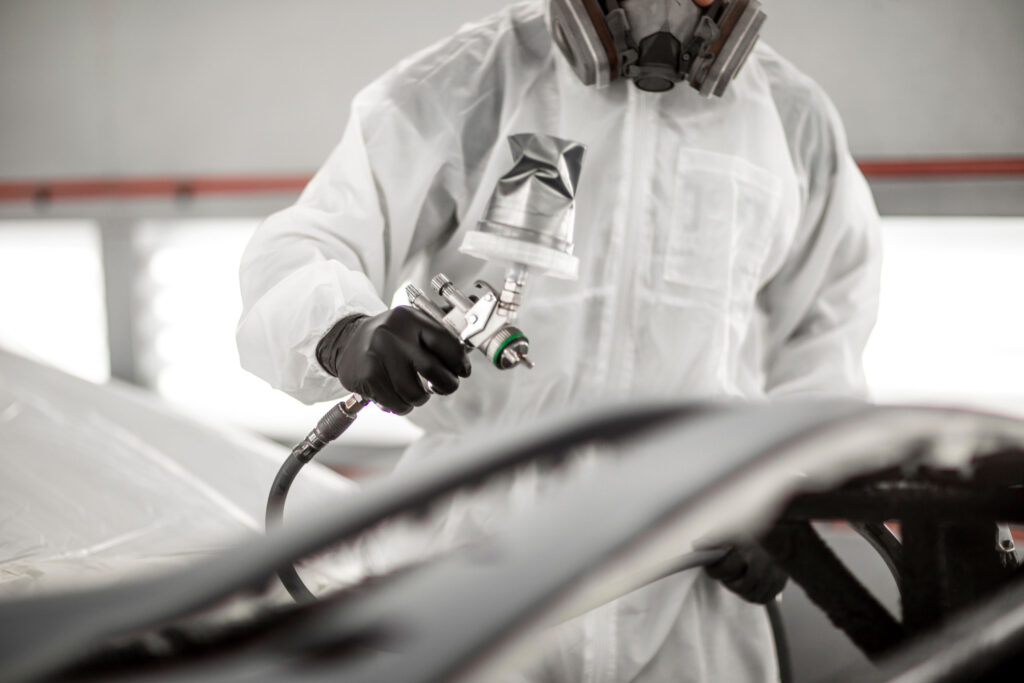How to Select an Architectural Metal Finish
AMICO does not constrain our design partners with a limited color palette. The world of color and finish is limited only to what’s available on the architectural metal market.
1 Fluoropolymer Paint
Fluoropolymer paint is a very versatile solution with many different formulations carrying different benefits and a wide array of colors and tends to carry a more flat sheen. This is a Polymer–based liquid color application that is sprayed on in production and different formulations require 2-4 coats and occasionally a primer for higher warranty finishes.
Popular Vendors and Swatches: PPG, Sherwin Williams, Lintec
PROS
- Broad color palette
- Mica and Metallic options
- Easy color matching
- Can close match to anodizing with better color consistency
CONS
- Thin application
- Getting to a longer warranty will require 3-4 coat products and thus cost more

2 Powder Coating
Powder coating is a thick, durable coating that typically offers a higher sheen.
During production, the metal is electrostatically charged, sprayed with a powder pigment, and then heated to cure the finish.
Popular Vendors and Swatches: Tiger, Sherwin-Williams, Interpon
PROS
- Durable, thick covering
- No VOC
- Hides imperfections in metal
CONS
- Bright colors tend to be less color-stable
- Limited color palette

3 Natural Finishes
Metals with no secondary finishes that will patina over time in different ways. These include corten steel, zinc, brass, bronze, and others
PROS
- No added finish
- No fading or damage problems
- Rich natural finishes
CONS
- Higher initial material cost
- Less control of aesthetic details
- Changes over time

4 FAQ
What is the cost difference between the different finishes?
Unfortunately, the answer is, that it depends. Prices change frequently, and grades within each finish vary widely. The best first step is to define the color, sheen desire, and warranty requirements and then discuss your project with AMICO team for quoting and budgeting.
How do I clean and maintain architectural metals?
Cleaning and maintaining of AMICO products are simple and straightforward. Often, mild soaps and detergents applied with a sponge or bristled brush is more than adequate. The frequency of cleaning will vary from location to location. Installations exposed to more smog, less rainfall, or salt spray will require a more frequent cleaning regimen. Below are links to some thorough cleaning guidelines from manufacturers and the AAMA.
Painted and Anodized Aluminum Surface Cleaning:
The AAMA has specific guidelines for the care of architectural metal products before installation and after.
Powder-Coated Aluminum Surface Maintenance and Cleaning:
Each manufacturer has its own detailed cleaning and maintenance guidelines, though they are similar. Linked below is a maintenance guide from Tiger Drylac, a leader in powder coating products.
Download Tiger Drylac Cleaning and Maintenance Guide Here
Cleaning Precautions:
- Correctly identify the aluminum finish to be cleaned when selecting an appropriate cleaning method.
- Never use aggressive alkaline or acid cleaners on aluminum finishes.
- Do not use cleaners containing trisodium phosphate, phosphoric acid, hydrochloric acid, hydrofluoric acid, fluorides, or similar compounds,
- Strong solvents or abrasive cleaners can cause damage to painted surfaces
- Test clean a small section first
- Do not mix cleaners
- Clean metal while it is shaded. Do not clean metal when it is hot; also avoid cleaning in freezing temperatures. Surfaces cleaned in these adverse conditions will streak or become tainted and will not restore to their original appearance.
- Do not use wire brushes, steel wool, sandpaper, abrasives or other similar cleaning tools, which will mechanically abrade the coating surface.
- Do not use excessive abrasive rubbing to remove stubborn stains.
- NOTE: Care should be taken to avoid overspray or run off of cleaner onto other building components such as glazing materials or sealants.
What do the different AAMA standards mean and what are the testing protocols?
Are there standards bodies for the different finishes?
Fluoropolymer Paints – American Coating Association







